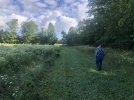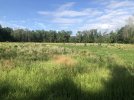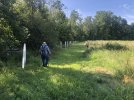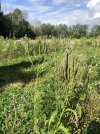H20fwler
5 year old buck +
I think it is great that you are taking it back to more of a natural balance.
I’ve done the same on a couple properties in Ohio.
We also had all kinds of marestail and every other thing we really didn’t want in the seed bank…there is nothing you can do about the seeds that are already there just waiting.
What you can do is is not give them a good start by planting natives that will out compete them.
What we did is plant a good mix of native grasses warm and cool season with a great blend of other stuff mixed in that we did want there.
Grasses we planted, big and little bluestem/Indian/switchgrass..mixed in were a bunch of varieties of coneflower, wildflowers, clovers, trefoil, chicory and partridge pea. After a couple years most of the undesirable plants couldn’t compete. We do have some weeds but it’s not a bad thing and they are loosing the battle against the native stuff. Marestail will not be able to compete with native grasses.
Adding shrub strips filled with with small trees shrubs that produce hard and soft mast and good browse will make the property more attractive to all kinds of wildlife. LOTS of awesome shrubs you can plant in the strips. Over time if you chose you can let the shrubs take over the field or not, it’s up to you and whatever your personal goals are but anyway you look at it, it will be great for wildlife and the soil.
It doesn’t happen overnight but you will be able to convert farm ground into native habitat that you want with things that you picked to plant there.
I’ve done the same on a couple properties in Ohio.
We also had all kinds of marestail and every other thing we really didn’t want in the seed bank…there is nothing you can do about the seeds that are already there just waiting.
What you can do is is not give them a good start by planting natives that will out compete them.
What we did is plant a good mix of native grasses warm and cool season with a great blend of other stuff mixed in that we did want there.
Grasses we planted, big and little bluestem/Indian/switchgrass..mixed in were a bunch of varieties of coneflower, wildflowers, clovers, trefoil, chicory and partridge pea. After a couple years most of the undesirable plants couldn’t compete. We do have some weeds but it’s not a bad thing and they are loosing the battle against the native stuff. Marestail will not be able to compete with native grasses.
Adding shrub strips filled with with small trees shrubs that produce hard and soft mast and good browse will make the property more attractive to all kinds of wildlife. LOTS of awesome shrubs you can plant in the strips. Over time if you chose you can let the shrubs take over the field or not, it’s up to you and whatever your personal goals are but anyway you look at it, it will be great for wildlife and the soil.
It doesn’t happen overnight but you will be able to convert farm ground into native habitat that you want with things that you picked to plant there.




